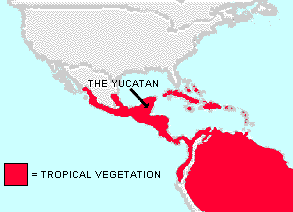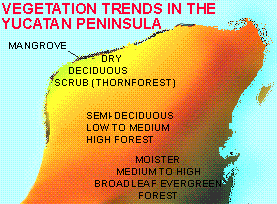An Overview of the
VEGETATION OF THE YUCATAN
 We all know that the Yucatan Peninsula lies well within "the tropics." However, sometimes we need to be reminded that tropical vegetation can consist not only of wet rainforest of the
"jungly" Tarzan kind, but also of dry, scrubby or even very dry grassy habitats
We all know that the Yucatan Peninsula lies well within "the tropics." However, sometimes we need to be reminded that tropical vegetation can consist not only of wet rainforest of the
"jungly" Tarzan kind, but also of dry, scrubby or even very dry grassy habitats
A very important feature of the Yucatan Peninsula's vegetation is this:
In general, the farther northwest you go, the more arid it gets, and the lower and more scrubby (and, often, spiny) the vegetation becomes.
 The vegetation zones gradually grade into one another. There are no sharp boundaries between the zones, except where mangrove suddenly appears in brackish water.
The vegetation zones gradually grade into one another. There are no sharp boundaries between the zones, except where mangrove suddenly appears in brackish water.
Ecologically, the northern Yucatan is an island, not a peninsula. On the east, north and west sides it is isolated by ocean, and in the south it is isolated from the rest of Mexico by greater rainfall and more luxurious forest than found in northern Yucatan.
One consequence of this ecological isolation of the northern Yucatan is that this region is home to many plant and animal species found no place else on Earth. About 10% of the plant species are endemic (found no place else). In the north, cacti are abundant and many of them endemic. Especially eye-catching are the columnar cacti. Unfortunately farming, ranching and fires -- as well illegal removal of plants for landscaping purposes -- cause these amazing cactus communities to be in danger of extinction.

The vegetation is profoundly affected by the alternating dry and wet seasons, as shown on the graph of our climate page. The above picture was taken during the middle of the dry season, in mid February, near Telchac Pueblo, Yucatan. Note that most but not all trees, bushes and vines have lost their leaves, and that the dominant background color is brown, not green. During the rainy season this looks like a solid wall of greenness.
During the dry season an amazing number of fires incinerate the landscape. Some are accidental but many, perhaps most, are set intentionally. Much burning is done in the belief that by burning weeds and bushes nutrients are released into the soil for use by crops. This is true to a certain extent, but burning also carbonizes humus, which serves as a sponge for soil moisture and nutrients, and also bakes the soil, changing its structure from crumbly to bricklike.
Combine the effects of burning, hurricanes, farming, ranching, real-estate development, legal and illegal logging and robbery of the most striking plants, and you get a vegetation that all too often consists of dead tree-snags rising up through impenetrable thickets of weeds.
The Yucatan's vegetation fares a little better in some spots along the coasts where extensive protected areas have been established -- such as at Celestún and Río Lagartos. Here we find one of the world's most productive ecosystems -- mangrove swamps. Don't overlook our special Mangrove Page where you can meet the four woody mangrove species found in the Yucatan's mangrove ecosystems.
You may be interested in reviewing the World Wildlife Fund's report on the Yucatan's critical bioregions.